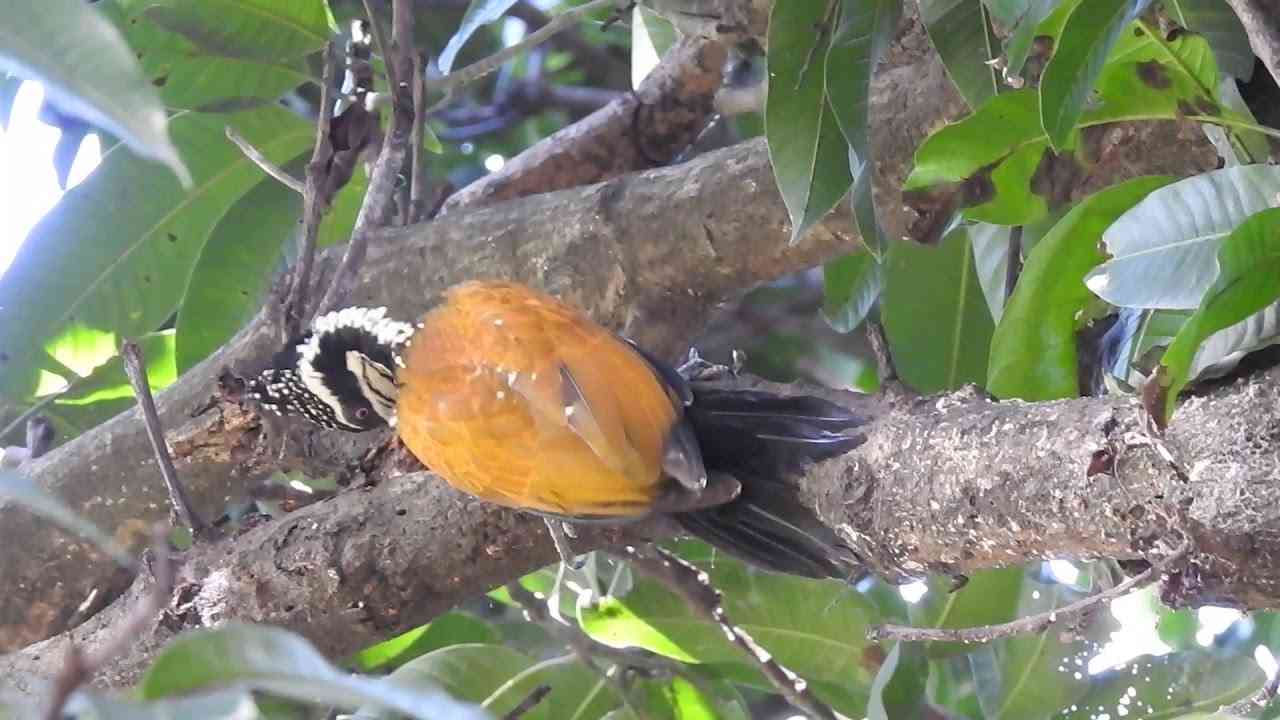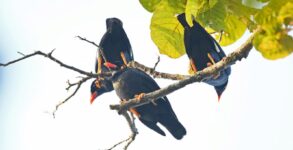Woodpeckers are brightly coloured members of the Picidae family, which includes other species such as piculets and wrynecks. A group of woodpecker birds known as the descent eats primarily on insects, fruits, and termites, and they build their nests in tree holes.
A total of more than 180 species of woodpeckers may be found around the world, and they are adaptable to a diverse range of habitats, including woods, deserts, jungles, and even urban environments. Woodpeckers, on the other hand, are not found in any of the following countries: Australia, Madagascar, New Zealand, or Antarctica. All woodpeckers, as well as wrynecks and piculets, are members of the Picidae bird family of birds. Among the bird species in all woodpeckers have a variety of plumage colours, but the most frequent are black, white, red, and yellow. Some species are also coloured in other hues such as orange, green, brown, maroon, and gold, to name a few. Brighter colours are commonly displayed in the form of showy patches, which are typically placed on the head, neck, or back, where they will be plainly visible. Furthermore, bright colours are more common in tropical woodpecker species, whose natural habitat contains a large number of vibrant flowers and plants.
The tongue of a woodpecker can be up to four inches long, depending on the species, and when it is retracted, it wraps around the back of the head. In order to assist the birds in extracting insects from trees and holes, many woodpecker tongues are barberated. Woodpeckers can lick up sap and insects, and they can also sip nectar from nectar feeders for hummingbirds and orioles, which they do with their quick tongues.
Most woodpeckers have zygodactyl feet, which means that they have two toes facing forward and two toes facing back. This allows them to grip trees and poles in a vertical position with greater strength. They use those toes, along with their thick tail feathers, to hold themselves against the branches of trees as they climb. The talons of many woodpeckers are longer and thicker than those of other birds, which allows them to maintain an extraordinary hold.
Bugs, sap, fruit, nuts, and seeds are among the foods that woodpeckers consume. Their natural predators are suckers and nut feeders, although they will also attend nectar or jelly feeders if they are placed in the yard or garden. In addition to kitchen scraps, woodpeckers may be interested in a variety of other meals, but they should only be supplied as rare treats in small quantities because they are not as healthful or nutritious as other foods. the family are more than 250 different varieties.
It is known that there are 12 species of woodpeckers that are found in India, which are listed below, with the flameback or goldenback being the most common type of woodpecker found widely scattered throughout the Indian subcontinent.
Greater Flamebacks
The greater flameback is a large species of flameback woodpecker that can be found throughout the Indian subcontinent, from the foothills of the Himalayas to the Western Ghats. It is a threatened species in the United States. A straight pointed head, a stiff tail that serves to provide support against tree trunks, and zygodactyl or “yoked” feet with two toes pointing forward and two backward distinguish this species from other woodpeckers. The lengthy tongue of the Greater Flameback can be dragged forward to catch insects, but it will also consume nectar if available.
Rufous Woodpecker
The rufous woodpecker is a very beautiful dark brown shade bird that may be found throughout the forests of southern India, where it feeds primarily on termites, ants, and fruits. The medium-sized brown woodpecker builds its nests in trees, preferably within ant nests, and forages for termites in groups of two. Rufous woodpeckers forage in groups of two or three on ant nests in trees, fallen logs, dung piles, ant and termite hills, and other ant-infested areas. It has been observed that they prey on ants belonging to the genera Crematogaster and Oecophylla. It has also been observed collecting nectar from the flowers of Bombax and Erythrina, as well as sap from the bases of banana fronds, in addition to eating insects. The keenk-keenk-keenk call is the most prevalent, but they also have other cries, such as a long wicka and a sequence of wick-wick notes, which are less common. A characteristic drumming note distinguishes them as well, which begins swiftly and then gradually calms down in time. Drumming can be heard throughout the year, however it is more common in the winter in southern India and peaks around March–April in Nepal, respectively.
Speckled Piculet
The speckled piculet is a small species of woodpecker that lives on the Indian subcontinent and is a member of the Picidae family. It is found only on the Indian subcontinent. The speckled piculet, like other species of woodpeckers, can be found in forests, wooded settings, and rocky hillsides, where it subsists on ants and termites, among other things.
Common Flameback
The Common Flameback species is another woodpecker from the Picidae family that may be found in India, tropical mangrove forests, Indonesia, and Singapore. It is a member of the Picidae family. The woodpecker is one of four species of flamebacks that can be found in Southeast Asia and the Indian subcontinent.
Yellow-crowned Woodpecker
The Yellow-crowned Woodpecker is a species of woodpecker that has a yellow crown on its head. The yellow-crowned woodpecker is a pied woodpecker that can be found on the Indian subcontinent. It is one of the smaller woodpecker species that can be found in India. Large white spots cover the back of the little pied woodpecker, also known as Mahratta woodpecker, which is strongly speckled with white patches.
Brown-capped Pygmy Woodpecker
This species of Indian woodpecker, also known as the brown-capped pygmy woodpecker or Indian pygmy woodpecker, is a little woodpecker with a brown cap. The Indian pygmy woodpecker is distinguished by its characteristic stripes, spots, and patches, and it may be found in India, Nepal, and Sri Lanka.
Black-rumped Flameback
Lesser goldenback woodpecker with a black throat and a golden rump is called as the Black-rumped Flameback. It is widely dispersed over the Indian subcontinent, and it is also known as black-rumped flameback or lesser goldenback woodpecker. It is the most common species of woodpecker found in India, and it may be found in urban areas, open woodland areas, and agricultural areas. It is also known as the lesser goldenback.
Depending on the weather the breeding season varies between February and July. During the breeding season, they can be heard drumming often. It is common for birds to excavate their own nest holes, which often have a horizontal entrance and drop into a cavity below. Birds have been known to take over the nesting sites of other birds. Nests have also been found in mud embankments, according to reports. The eggs are deposited into the cavity that has not been walled. The average clutch size is three eggs, which are elongate and glossy white in colour. After around 11 days of incubation, the eggs hatch. After around 20 days, the chicks are ready to leave the nest.
White-naped Woodpecker
The white-naped woodpecker is another flameback species with a red crown that can be found in central and southern India, as well as in Sri Lanka. A breeder of the Indian Subcontinent, the flameback woodpecker bird can be found in open woodland habitats throughout the country, including Delhi.
Heart-spotted Woodpecker
The Heart-spotted Woodpecker is a species of woodpecker that has heart-shaped spots on its back. The heart-spotted woodpecker is one of the family’s members, and it can be found in the Indian Himalayas and Southeast Asia’s mountain ranges. They forage in pairs across the Western Ghats and central forests of India and have a range that extends from Bangladesh to Vietnam.
Streak-throated Woodpecker
When it comes to colour, the streak-throated woodpecker is an olive green bird with a red head and a black moustache. The green woodpecker is a medium-sized bird that may be found in the Indian subcontinent. It is not a common woodpecker of the forest, and it can be seen in Corbett National Park.
White-bellied Woodpecker
The great black woodpecker, also known as the White-bellied woodpecker, is a large black bird with a red crown and a white belly that is one of the largest species of woodpecker. It is also one of the most beautiful black birds on the planet. In the Indian subcontinent, tropical areas, and Southeast Asia, the White-bellied Woodpecker can be found in evergreen forests, particularly in the Indian subcontinent.
Lesser Yellownape
The Lesser Yellownape is a species of yellownape that is smaller than the Greater Yellownape.With a brill iant yellow tufted nape and a blackish tail, the Lesser Yellownape species of birds stands out among the other green-colored birds. This species, which may be found in peninsular India and the Indian subcontinent, as well as Southeast Asia, is a common breeder in both regions.


















